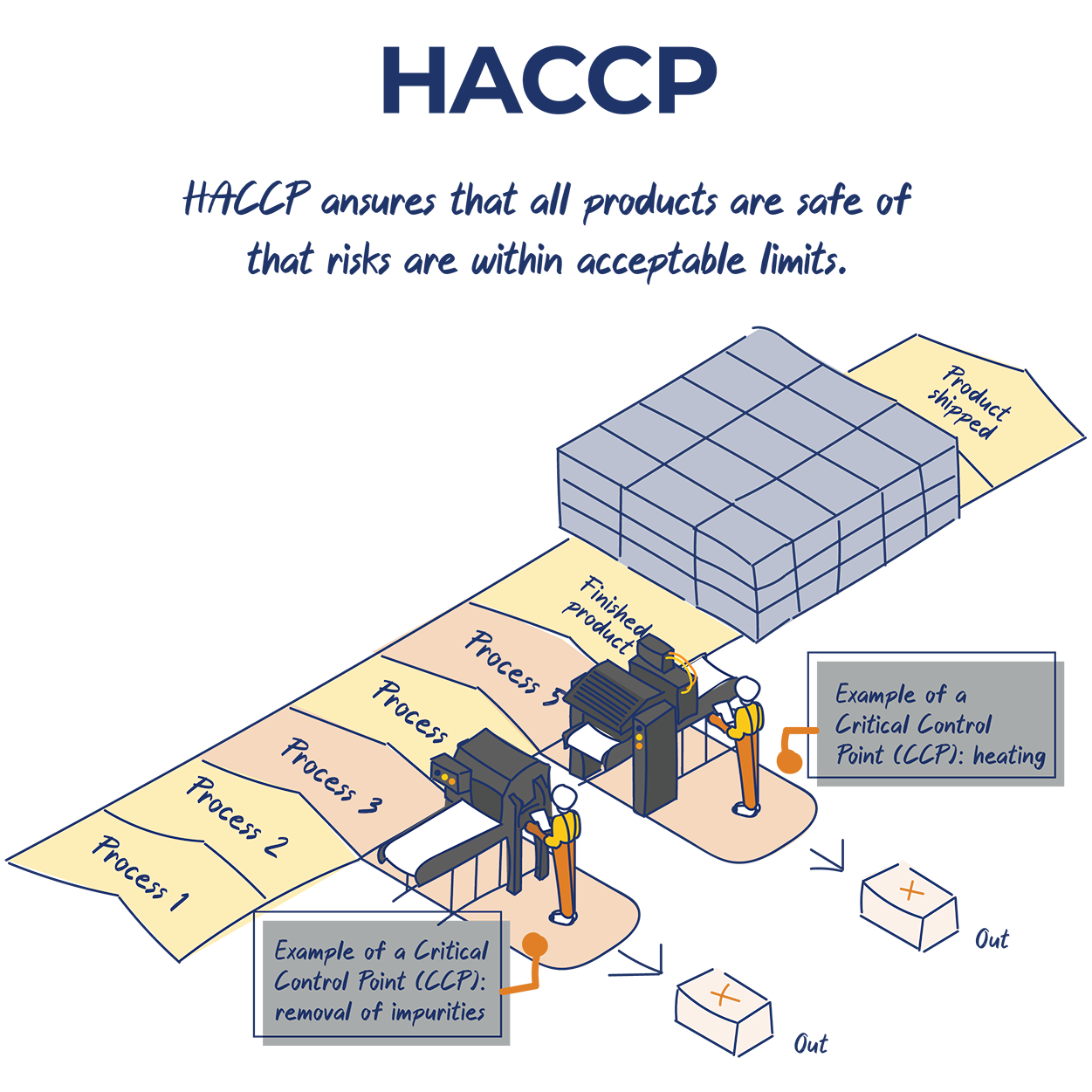What is a HACCP Flow Chart?
Nov 14, 2024

Every food business has its own unique food process operations to come up with for its product. These operations describe all the everyday activities of a business and are comprehensively analyzed in a HACCP plan. This step is done by building a HACCP flow chart or otherwise known as a HACCP flow diagram. This diagram is a graphical representation of all your processes and is usually considered a critical tool and the most difficult part of a HACCP plan. The construction of a HACCP flow chart is one of five preliminary steps before applying the 7 HACCP principles as described by Hazard Analysis and Critical Control Point (HACCP) System and Guidelines For Its Application in the Codex Alimentarius Recommended International Code Of Practice General Principles Of Food Hygiene.
What is a HACCP flow chart?

A HACCP flow chart is a graphical representation of the entire manufacturing process of your food business.
A HACCP flow chart represents the flow of food materials in your food business starting from receiving the raw materials to serving your finished products.
HACCP food safety system requires a detailed and comprehensive food flow chart to properly identify the associated hazards in your manufacturing process.
Operations that must be included in the flow chart include:
- Raw material receiving
- Inspection (for any type of hazard)
- Batch weighing
- Processing (e.g., thermal processing, mechanical processing, etc.)
- Packaging
- Quality inspections
- Rework (where applicable)
- Waste flow
- End product
All food charts are almost different and have complex processes. They are uniquely based on your processing structure. Depending on the complexity of your whole processing steps, your food flow chart may become difficult to make. A food flow chart is composed of flow chart symbols which are usually basic shape objects. These symbols can include rectangles that contain the process, inward and outward arrows to suggest the flow of the process, diamonds for steps requiring decisions, and circles that indicate the starting and ending point. Other flow chart symbols may include curved lines, connector lines, and other basic shape objects such as rhomboid shapes to signify input materials.
Why do we need to understand the flow of food definition?
The flow of food in a processing setup pertains to the path that the raw materials go through to become the finished product that is ready to be served. Determining this whole process is an important job for the whole HACCP team. Each step in your food manufacturing process has its functions. Whether it be receiving raw materials, processing, packaging, or anything in between, all of these steps were included to perform certain tasks. Knowing the logical flow of foods through the assembly line manufacturing allows your HACCP team to see what hazards may have a high risk of occurring.
The flow of food normally starts from receiving the raw materials which then go straight to manufacturing or storage. Direct use of raw materials requires extensive inspection because the products will be immediately used for production. In such process steps, physical hazards are most likely to be detected such as insect parts, glass shards, or pieces of metal. Failure to detect these hazards at this point can cause other subsequent contaminations such as microbial growth and put public health at risk.
Is a HACCP flow diagram mandatory for food businesses?
A HACCP flow diagram is a helpful tool and a prerequisite requirement for making a HACCP plan. It is the last part of the preliminary steps before applying the HACCP principles. Your hazard analysis stage will be based on this document. Depending on your country's legislation regarding the requirement of a HACCP food safety system, it may be required to have a HACCP flow diagram for your food business. In case you need to be HACCP certified, you will definitely be required by law to have it.
A food flow chart is also useful even if not for HACCP purposes. Your business can benefit from mapping out your entire process which can help you easily identify at which point errors usually occur.
How to create a HACCP flow chart with 5 steps?
STEP 1. Define all processes in your company

As already described, you should document all HACCP process steps you have in your food business, nothing more or less. This step starts from receiving until the food is delivered to the end-users.
Examples of the flow of food in the food business:
- Picking herbal products
- Ordering/buying products
- Receiving products
- Storing products
- Thawing/defrosting
- Cleaning dirty vegetables
- Preparing non-animal food
- Preparing animal food
- Cooking Cooling
- Freezing
- Re-storing
- Re-heating
- Drying
- Packaging/labeling
- Transporting food
- Serving Food donation
Despite repeatedly mentioning that you need to indicate all processes involved, there is no need to point out non-processing steps. Steps like cleaning and sanitizing, inspection, audits, testing, etc. do not have to be added to the flow chart. Focus only on the steps that your raw materials go through before becoming a finished product in your menu.
Because a HACCP plan is process and process-specific, your food flow chart must be the same as well. You will be required to make separate flowcharts for all your products if they undergo different processing methods. This makes it harder if you have a wide variety of products with different manufacturing processes.
STEP 2. List all HACCP process steps
After defining the steps, list all your processes according to your facility's real-life situation. It might seem that there is only one simple option, but usually, there are several ways that HACCP processes can change for the location. For example, after preparing the food, it can go directly to serving without being cooked. Make sure that all arrows are properly used and will not cause confusion. Before proceeding to the next step, verify your process flow chart if all information is correct.
STEP 3. Define Control Points and Critical Control points.
Depending on the region, you sometimes need to validate and mark your HACCP flow chart, whether your process steps are Control Points (CP), or Critical Control Points (CCP). You may need to list each step of the HACCP process and note down all possible hazards for each step. Evaluate the possible hazards of each step separately based on their severity and likelihood of occurring. Some steps can have a single hazard, whereas others can have more than one.
STEP 4. Define control measures

The next step is to define and mark which control measures must be monitored, whether measuring the time, temperature, or quality. These control measures can be time, temperature, quality, and the like. Because the flow chart we generate for you is based on general knowledge from established businesses, there will be instances that you would have to specify which measures need to be controlled specifically. Do not worry because this is an easy task and will only take a few clicks to finish. The process will still be way faster than making a flow diagram on your own. Other specifications such as which process step is a critical control point or a control point may be specified on your end.
Step 5. Verify your HACCP flow chart

After completing your flow diagram together with the whole HACCP plan, you always need to double-check if your HACCP plan is correct and fits your food manufacturing process perfectly.
These key times when you need to revise your flow chart are:
- At least once a year as an update or to apply revisions.
- Whenever there has been a change to any of your HACCP processes, like installing new equipment or removing existing equipment from the process.
- Whenever you start to use a new ingredient, that can have an important impact on the production process. For example, a raw material containing an allergen.
- When revisions from an auditing firm require you to change your processes.
Things can be very variable, especially in the food business, so the more flexible your HACCP flow chart is for modifying, the better.
Conclusion.
The HACCP flowchart should provide a clear and simple explanation of all the steps involved in the process. The team responsible for HACCP should check the flow diagram on-site in to test its accuracy. When incomplete, it’s imperative to plan the necessary changes and to adapt and improve the HACCP plan. The failure to revalidate the flow process diagram and other elements in the HACCP plan has led to serious outbreaks of food poisoning. Fortunately, verification in the form of a systems audit will confirm the flow process diagram is representative of what is actually happening in practice or highlights deficiencies.
Roberto Beltran, Chemical Engineer.
"I'm an engineer with experience in Food process and quality since 2011, with additional certifications in food safety systems, such as FSSC22000 and SQF. I'm in charge of the creation of food safety plans for restaurants and facilities."

What is a Preventive Control Plan (PCP) in Canada?

16 infected due to California’s Raw Farms LLC Recall: What You Need to Know to Prevent Outbreaks

Assessing the Effectiveness of Your HACCP Plan: A Year Later
Join our Food
Safety Community!
Stay ahead of the curve by exploring emerging
trends and technologies in food safety.

